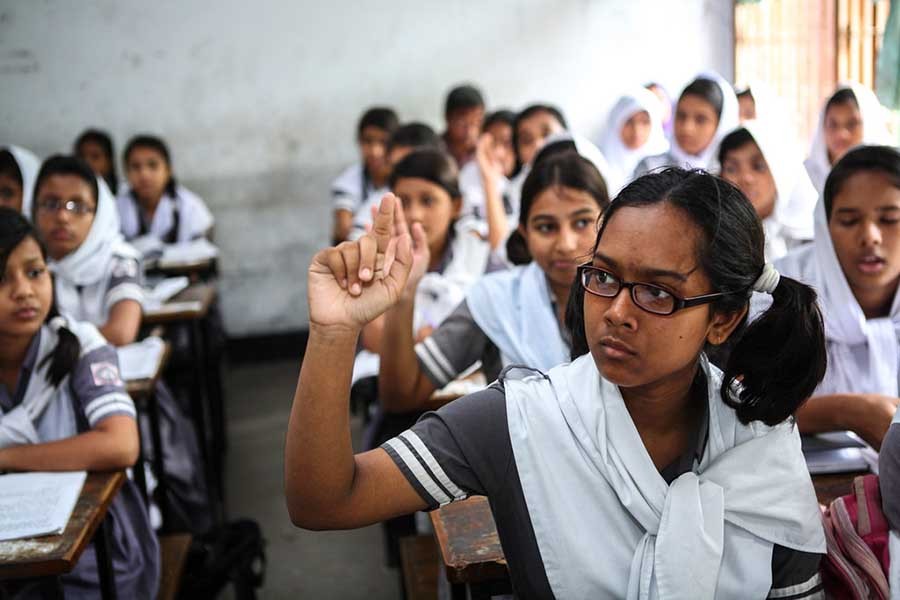Education and skill gaps for students and job-seekers are always a serious concern anywhere in the world. In a country burdened with an oversize population, this turns out to be nightmarish. Three studies conducted by the World Vision have focused on learning comprehension of young learners, participatory role of genders in decision-making at the household level and a mismatch between education, skills on the one side and demand on the other.
The results of the study on education are quite revealing. Under a programme 'Learning for change', the study finds that only 46 per cent students of grade-III can comprehend what they read. This is against the global average of 80 per cent students of class III capable of reading with comprehension. Anything less than 80 per cent is considered a moderate risk for dropout and calls for action to avert the prospect. A rate of 50 per cent for students with no comprehension at reading is considered a critical risk for dropout. Add to this the 21 per cent students at this level, who cannot even recognise the most common words and letters and the picture that emerges of the education system followed here becomes highly disturbing.
The study on employment only corroborates the fact that the inappropriate system is continued up to the tertiary level. It finds that 3.0 million youths aged between 18 and 35 are unemployed. Another report prepared about a couple of years ago by the International Labour Organisation found that 40 per cent youths aged between 15 and 24 are 'not in education, employment or training (NEET)'. The pattern is unlikely to have changed over the past two years. This is awfully frustrating. A significant proportion of the unemployed has even given up looking for employment because of the hopelessness of any prospect.
Of the total population, the ILO reported, 47.8 per cent were young people. Of them 32.3 per cent were within the 15-24 age bracket, while 46.6 were under the age of 15. This composition of the demography too may not have undergone a radical transformation by this time. Evidently, here is a land where the majority are young people of working age. Bad demographic planning can lead to the ticking of a time bomb and conversely a proper plan with the country's population can garner rich dividends for the country.
If the education system and the skill development initiatives are any guide, the situation is simply deplorable. While the country cannot provide for 30 million unemployed including graduates and undergraduates, there are 400,000 foreigners employed here-the majority of whom are in the garment sector. They take away $5.0 billion annually. A flawed education system is churning out graduates or undergraduates who prove a misfit to jobs on offer in the manufacturing or industrial sector. This is evident from the fact that the unemployed rate among those with secondary post-secondary non-tertiary education is only 6.2 per cent -half that of those with tertiary education. Technical and vocational education at those levels may have been responsible for the low rate of unemployment.
Clearly, a thorough review of the country's education system is well in order. If education does not help build a well-paid career, it should provide with practical knowledge and on-the-field training enough for developing entrepreneurship or at least self-employment. Higher education should be up to the task of competing with candidates at the international level. That the foreigners employed here in the garment factories have the training, right kind of attitude and language skills is their plus point. This is an area where local candidates should have proved their worth by this time. Unfortunately, this is not happening yet. But why? Education and expertise required for jobs at the mid or top levels in garments factories are unlike those for civil service or teaching at universities or conducting research in laboratories. This should not have been beyond the capability of local educated youths.
Higher education should be limited to those who are especially meritorious. The mediocre and the above mediocre should be selected for the manufacturing and service sector respectively. The readymade garments sector here is more a service sector than a manufacturing one. There should be an attempt to turn it more manufacturing than service-oriented. The manufacturing sector is getting diversified. This is a good sign and it will require specialised expertise in the days to come. The work force has to be readied accordingly.
One silver-lining, though, is that among the students of the grade-III, girls were better placed in reading competency with only 18 per cent not achieving the standard set while it was 25 per cent among boys. Indeed, girls are performing better not only at the secondary and higher secondary levels but also at the tertiary levels. Even in subjects once considered an exclusive preserve for male students, female students are topping the merit list. This augurs well because, right now participatory gender role may not have exerted an influence on decision-making in household matters but women education becomes decisive in educating children better and improving their health.


